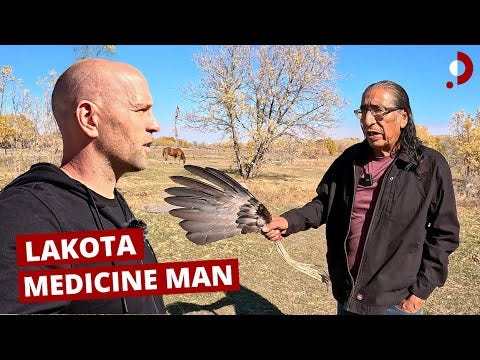Lakota Elder Wowitan Uha Mani Speaks To Peter Santenello: "I'm a Lakota!"
The perspectives of a Lakota Elder align with my book, "Federal Anti-Indian Law"
On December 4, 2022, Lakota Elder Wowitan Uha Mani (Christian name: David Swallow, Jr.) spoke with filmmaker Peter Santenello about why he’s not a “Native American” (and why Peter is), about the history and future of the Lakota, and about control, freedom, and what the world needs.
You can watch it here:
The 26 minute video makes a nice companion to my book, Federal Anti-Indian Law: The Legal Entrapment of Indigenous Peoples.
Two examples:
“I’m not an Indian. I’m not a Native American. I’m a Lakota. …The key to this thing is people should know the truth.”
My book:
There is no such entity as “Indian” except among the peoples of the Indian subcontinent. Christopher Columbus knew that; he just didn’t know where he was when he “discovered America.” The ensuing “misrecognition of natives as indians is both oppressive and a prison of false identities.”
In the 1960s, Americans tried to make the “Indian problem” go away by linguistically incorporating Indigenous peoples into America—“Native Americans,” to mix with all the other “hybrid Americans.”
The Santee Dakota poet, musician, and activist John Trudell responded to this by saying:
“They change the name and treat us the same.”
John also spoke to Natives who were willing to adopt the new labels: “We’re too busy trying to protect the idea of a Native American or an Indian—but we’re not Indians and we’re not Native Americans. We’re older than both concepts. We’re the people. We’re the human beings.”
Both “Indian” and “Native American” are colonizer names.
“Tribal Council: They shouldn’t use that name. They are an unincorporated corporation created by the 1934 act of Senator Howard and Senator Wheeler {The Indian Reorganization Act}. So that’s not ours.”
My book:
The 1934 Indian Reorganization Act disavowed the destructive Allotment Act, which broke up Native communal landholding into nuclear households and handed “surplus” Native lands to non-Natives.
But Roosevelt’s reorganization carried its own version of assimilation; it pushed Native peoples to replace their many different traditional governments with a standardized business corporation model of Tribal Councils, under federal supervision, in order to make it easier for Indigenous lands and peoples to become part of the U.S. national economic system.
Despite halting the allotment of Native lands, the New Deal did not disavow the U.S. claim to own Native lands and have plenary power over Native peoples.






Such clarity Peter! Thank you for reposting this excellent interview and connecting it to your wonderful book.
It's a great perspective. Over the last decades the Navajo have reclaimed Diné (the People) as their proper name, vice Indian or Native American. They're just the People. Conquering peoples, whether European, Asian, or indigenous, always impose their order on subjugated peoples.